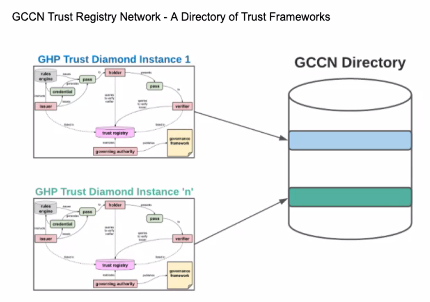Meeting Date
- 2021-07-01 10am ET
Attendees
- Drummond Reed
- Ken Adler
- Marie Wallace
- Mike Richardson
- Jim St.Clair
- Riley Hughes
- sankarshan
- Lucy Yang
- John Walker
Main Goal of this Meeting:
Discuss the primary deliverables and action items to be performed until the next meeting.
Agenda
| Time | Item | Lead | Notes |
| 5 min | Start recording | Chairs | |
| 5 min | Introduction of new members | All | |
| 5-10 mins | Report on action item from last week: ACTION: Drummond Reed to create the X.509 PKD interop wiki page and baseline proposal |
| |
| 5-10 mins | OpenAPI in github and Trust Registry Relay decision | Darrell O'Donnell virtually Drummond Reed leading discussion | |
| 15 mins | Discuss the GCCN Trust Registry Network Definition document | ||
| 20 mins | Other technology approaches and open discussion
| All | |
| 10 mins | Review of action items & prep for next meeting | Chairs |
Recording
<link to go here>
Notes
- New member introductions
- X.509 PKD interop wiki page and baseline proposal - Drummond Reed
- This proposal is the beginning of discussion about how the Trust Registry Protocol can include conventional X.509 public key directories (PKDs)
- OpenAPI in github and Trust Registry Relay decision - Darrell O'Donnell(virtually)
- Discuss the GCCN Trust Registry Network Definition document - John Walker and Lucy Yang
- John Walker shared the strawman document Defining the GCCN Trust Registry Network
- Other technology approaches and open discussion
- Ken Adler - trustregistrynetworks.org
- This came out of an effort to expose cryptographic primitives in a standard way.
- The GCCN use case was a "deceptively simple" example of the need.
- So Ken and his team started an open source project.
- Requirements included: operating at the edge, low resource consumption, policy-as-code, describing governing authorities and digital trust ecosystems in a delarative manner.
- Currently several Thoughtworks devs are working on the project
- The hope is that the project can fit within various architectures that need these capabilities.
- Location:
- TRAIN - Mike Richardson
- ACTION: Mike Richardson to see if he can arrange for TRAIN rep to come to the July 15 meeting
- https://gitlab.grnet.gr/essif-lab/infrastructure/fraunhofer
- Ken Adler - trustregistrynetworks.org
- Discussion of machine-readable rules
- Jim St.Clair is assuming that there is a need for rules for ultimately making trust decisions
- Ken Adler provided feedback that the baseline was just verifying DIDs and URIs
- John Walker shared that the rules about something like Good Health Pass travel requirements will be in a governance framework ("inside the trust diamond"), but that they don't necessarily have to be in machine-readable rules, but the different TRs can have different levels of support for machine-readable rules
- So the business rules reside at two levels - what are the rules of interacting with the TR, and what are the rules with the ecosystem for a particular TR
- We need to explore the machine-readable mechanisms
- Review of action items & prep for next meeting
- Darrell O'Donnell Focus on a definition of the MVP
- John Walker the set of user stories that will give us the requirements for the "absolutely bare bones"
- Lucy Yang will share a diagram of the user flow from a GCCN standpoint
Decisions
- None
Action Items
- ACTION: Mike Richardson to see if he can arrange for TRAIN rep to come to the July 15 meeting
- ACTION: Darrell O'Donnell to focus on a definition of the Trust Registry Protocol MVP
- ACTION: John Walker to define the set of user stories that will give us the requirements for the "absolutely bare bones"
- ACTION: Lucy Yang to share a diagram of the user flow from a GCCN standpoint
